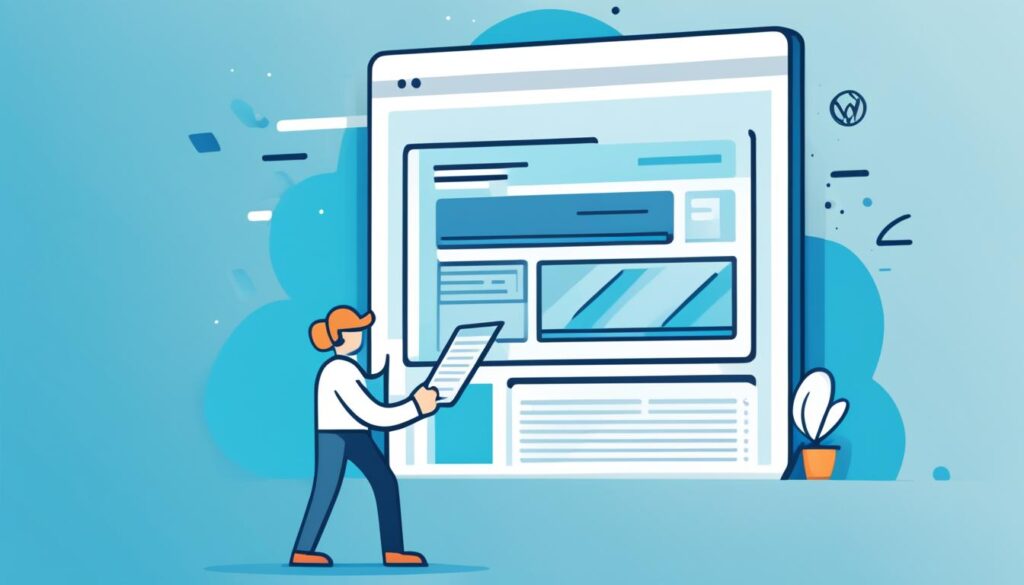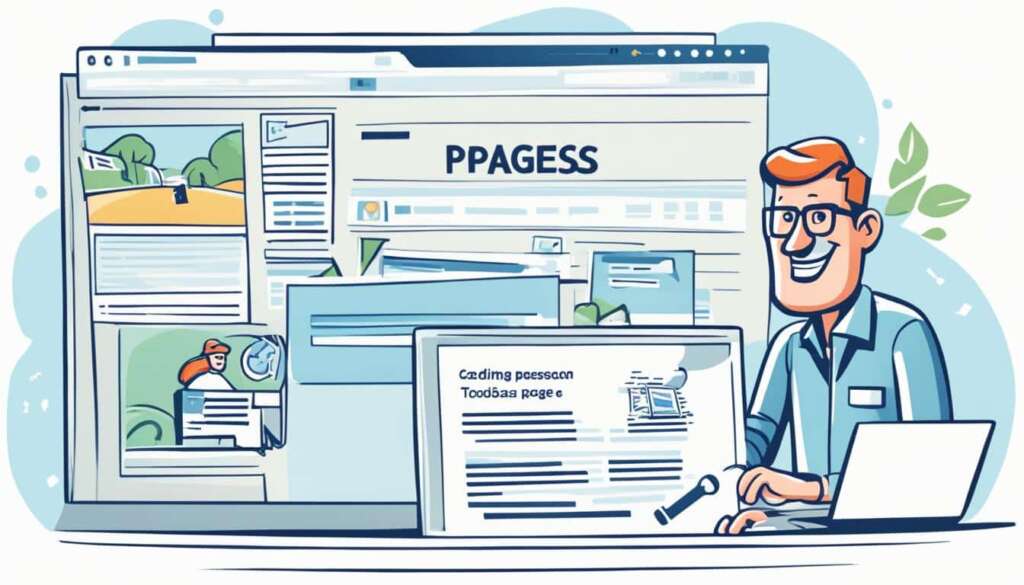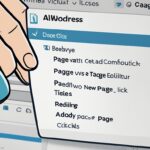Table of Contents
Welcome to our comprehensive guide on how to edit pages on WordPress and master the art of web page management. Whether you’re a seasoned WordPress user or just starting out, this article will provide you with the essential steps and techniques to seamlessly edit your website pages with ease.
When it comes to web page management, WordPress offers a user-friendly and intuitive platform that empowers you to make changes and updates effortlessly. With its powerful features and flexible editor, you have full control over the content and design of your pages.
In the following sections, we will explore the WordPress page editor, walk you through the step-by-step process of editing a page, discuss advanced editing techniques, and conclude with key takeaways to enhance your page editing skills on WordPress.
Key Takeaways
- Mastering WordPress page editing is crucial for effective web page management.
- The WordPress page editor provides a range of features and functions to customize your pages.
- Editing a page on WordPress involves accessing the page editor, making content changes, and adjusting settings as needed.
- Advanced editing techniques include customizing page layouts, incorporating media elements, and optimizing for search engines.
- By mastering these techniques, you will have the skills to flawlessly manage your web pages on WordPress.
Understanding the WordPress Page Editor
In this section, we will dive into the WordPress page editor, exploring its various features and functions to help you understand how to navigate and utilize it effectively.
When it comes to managing your website’s content, the WordPress page editor is an invaluable tool. Whether you’re a beginner or an experienced user, this intuitive editor provides you with a range of powerful editing features that allow you to create, edit, and optimize your web pages with ease.
“The WordPress page editor is your virtual canvas, empowering you to shape your website’s content and design according to your vision.”
One of the key advantages of the WordPress page editor is its user-friendly interface. With its simple and intuitive design, you can effortlessly navigate through different editing options and make changes to your web pages without any technical expertise.
Let’s take a closer look at some of the key features offered by the WordPress page editor:
1. Visual Editing
The WordPress page editor offers a visual editing mode that allows you to create and edit your web page in a WYSIWYG (What You See Is What You Get) format. This means that you can directly edit the content and see the changes in real-time, making it easy to visualize the final result before publishing.
2. Text Formatting
With the WordPress page editor, you have full control over the formatting of your text. You can easily change font styles, apply headings, create lists, and add emphasis using bold or italics. The editor also provides options for text alignment, indentation, and spacing to ensure your content appears clean and visually appealing.
3. Media Integration
The WordPress page editor allows you to seamlessly integrate various media elements into your web pages. You can easily insert images, videos, and audio files to enhance the visual appeal and engagement of your content. With a simple click, you can upload media directly from your device or choose from your media library.
4. Customization and Layout
Flexibility is a key aspect of the WordPress page editor. You can customize your page layout using different blocks or modules, rearranging and resizing them to suit your preferences. This enables you to create dynamic and visually stunning pages that captivate your audience.
5. SEO Optimization
The WordPress page editor provides you with essential tools to optimize your web pages for search engines. You can easily add meta tags, meta descriptions, and alt text to your content, ensuring that your website ranks higher in search engine results and attracts more organic traffic.
Now that we’ve explored the key features of the WordPress page editor, you have a solid foundation to unleash your creativity and effectively manage your web pages. In the next section, we will walk you through the step-by-step process of editing a page on WordPress, covering everything from accessing the page editor to fine-tuning your settings for optimal results.
Steps to Edit a Page on WordPress
In this section, we will walk you through the step-by-step process of editing a page on WordPress. Whether you’re a beginner or an experienced user, understanding how to edit a page is crucial for maintaining a dynamic and engaging website. By following these simple steps, you’ll be able to make changes to your page content and adjust various settings to optimize your web presence.
Accessing the WordPress Page Editor
The first step in editing a page on WordPress is accessing the page editor. To do this, log in to your WordPress dashboard and navigate to the “Pages” section. Find the specific page you want to edit and click on it to open the editor.
Making Changes to Content
Once you’re in the WordPress page editor, you can start making changes to the content of your page. The editor provides a user-friendly interface with a wide range of formatting options, allowing you to easily add or edit text, images, videos, and more. You can use the toolbar at the top of the editor to apply different formatting styles, create headings, insert links, and add media elements.
Pro Tip: When editing content, it’s important to maintain consistency in your writing style and use appropriate headings and subheadings to enhance readability.
Adjusting Page Settings
In addition to modifying the content, you may also want to adjust certain page settings to optimize its performance. WordPress provides various options to customize your page, including:
- Setting the page title and URL
- Assigning the page to a specific category or tag
- Choosing a featured image
- Configuring SEO settings
- Enabling or disabling comments
By exploring these settings and understanding their impact, you can enhance the visibility and functionality of your page.
| Page Title | Home |
|---|---|
| URL | https://www.example.com/home |
| Category | Blog |
| Tag | Web Design |
| Featured Image |

|
| SEO Settings | Meta description, keywords |
| Comments | Enabled |
By utilizing these page settings, you can customize your page to align with your branding and SEO goals.
Now that you have a clear understanding of the step-by-step process of editing a page on WordPress, you can confidently make changes to your website to keep it up-to-date and engaging for your audience.
Advanced Editing Techniques on WordPress
In this section, we will explore advanced editing techniques on WordPress to enhance your webpage’s visual appeal and functionality. These techniques include customizing page layouts, adding media elements, integrating plugins, and optimizing your page for search engines.
Customizing Page Layouts
One of the key advantages of WordPress is its flexibility in customizing page layouts to suit your specific needs. With advanced page editing options, you can effortlessly rearrange elements and create unique layouts that align with your branding or content strategy.
Here are some tips for customizing page layouts:
- Choose from a wide range of pre-designed templates or create your own layout from scratch.
- Utilize drag-and-drop page builders to easily move and resize elements.
- Experiment with different column arrangements to achieve your desired design.
- Add custom CSS code to fine-tune the appearance of your page.
By leveraging these customization features, you can create visually stunning and user-friendly webpages that leave a lasting impression on your visitors.
Adding Media Elements
Visual content plays a vital role in engaging your audience and delivering your message effectively. WordPress offers various options for incorporating media elements into your pages, such as images, videos, and audio files.
Here are some ways to add media elements to your pages:
- Upload images directly from your device or choose from a library of royalty-free stock photos.
- Embed videos from popular platforms like YouTube or Vimeo to enrich your content.
- Integrate audio files to create a multimedia experience for your visitors.
Remember to optimize your media files for web to ensure fast loading times and optimal performance.
Integrating Plugins
WordPress’s plugin ecosystem provides a wide range of functionalities and enhancements for your website. By integrating plugins, you can extend the capabilities of your pages and offer advanced features to your visitors.
Here are some popular plugins you can consider:
- Yoast SEO: Optimize your page for search engines with advanced SEO tools.
- Contact Form 7: Easily add contact forms to your pages for seamless communication.
- WooCommerce: Transform your page into an online store with powerful e-commerce capabilities.
- WP Rocket: Speed up your page’s loading time with caching and performance optimization.
With a vast array of plugins available, you can personalize your webpage’s functionalities and provide an enhanced user experience.
Optimizing Your Page for Search Engines
Search engine optimization (SEO) is essential for improving your webpage’s visibility and attracting organic traffic. By optimizing your page, you can increase its chances of ranking higher in search engine results.
Here are some SEO best practices to consider:
- Optimize your page’s meta title and description with relevant keywords.
- Utilize heading tags (H1, H2, H3) to structure your content and improve readability.
- Include internal and external links to authoritative sources.
- Optimize your images by using descriptive alt tags and compressing their file sizes.
By implementing these advanced editing techniques and optimizing your page for search engines, you can create a visually appealing and SEO-friendly website that captivates your audience and drives meaningful engagement.
“Advanced page editing techniques on WordPress allow you to unleash your creativity and design visually stunning webpages that leave a lasting impression. By customizing page layouts, adding media elements, integrating plugins, and optimizing for search engines, you can elevate your website’s user experience and drive meaningful results.”
– Michelle Thompson, Web Design Expert
Conclusion
After exploring the various aspects of editing pages on WordPress, we can conclude that it is a powerful tool for web page management. By following the step-by-step guide provided in this article, you will be able to edit your pages seamlessly and make necessary changes effortlessly.
The WordPress page editor offers a range of features that enable you to customize your content, adjust page settings, and enhance the overall design. Whether you are a beginner or an experienced user, mastering these techniques will equip you with the necessary skills to create visually appealing and engaging web pages.
In summary, editing pages on WordPress involves accessing the page editor, making content modifications, and optimizing settings for optimal results. Additionally, advanced techniques such as customizing page layouts and integrating plugins can elevate your web design to the next level.
With this comprehensive guide, you now have the knowledge and tools to confidently manage your web pages on WordPress. By implementing these strategies, you can create professional-looking websites and attract and retain your desired audience. Start editing with WordPress today and take your online presence to new heights!
FAQ
How do I edit a page on WordPress?
To edit a page on WordPress, you can follow these steps:
1. Log in to your WordPress dashboard.
2. Navigate to the “Pages” section.
3. Locate the page you want to edit and click on it.
4. The WordPress page editor will open with the content of the page.
5. Make the necessary changes to the content, such as adding or deleting text, images, or links.
6. Once you are satisfied with the changes, click on the “Update” button to save the edits.
What are the features of the WordPress page editor?
The WordPress page editor offers several features that allow you to customize your pages:
1. Text formatting options to style your content.
2. Media library to easily add images, videos, and audio files.
3. Drag and drop functionality for rearranging content blocks.
4. Plugin integration for adding extra functionality to your pages.
5. SEO options to optimize your page for search engines.
6. Revision history to track and revert changes made to the page.
Can I change the layout of a page on WordPress?
Yes, you can customize the layout of a page on WordPress by using a variety of methods:
1. Utilize page builder plugins that offer pre-designed templates and drag-and-drop functionality for creating unique layouts.
2. Edit the page’s CSS code to modify the styling and positioning of individual elements.
3. Use custom page templates provided by your WordPress theme to apply different layouts to specific pages.
4. Install and activate a theme that offers flexible layout options, allowing you to easily change the overall structure of your pages.
How do I optimize my WordPress page for search engines?
To optimize your WordPress page for search engines, consider the following:
1. Use relevant keywords in your page’s title, headings, and content.
2. Optimize image file names and alt tags with descriptive keywords.
3. Install an SEO plugin, such as Yoast SEO, to streamline the optimization process and provide guidance.
4. Create unique and engaging meta descriptions for your pages.
5. Build internal and external links to improve your page’s visibility.
6. Regularly update and add fresh content to your pages to attract search engine crawlers.












